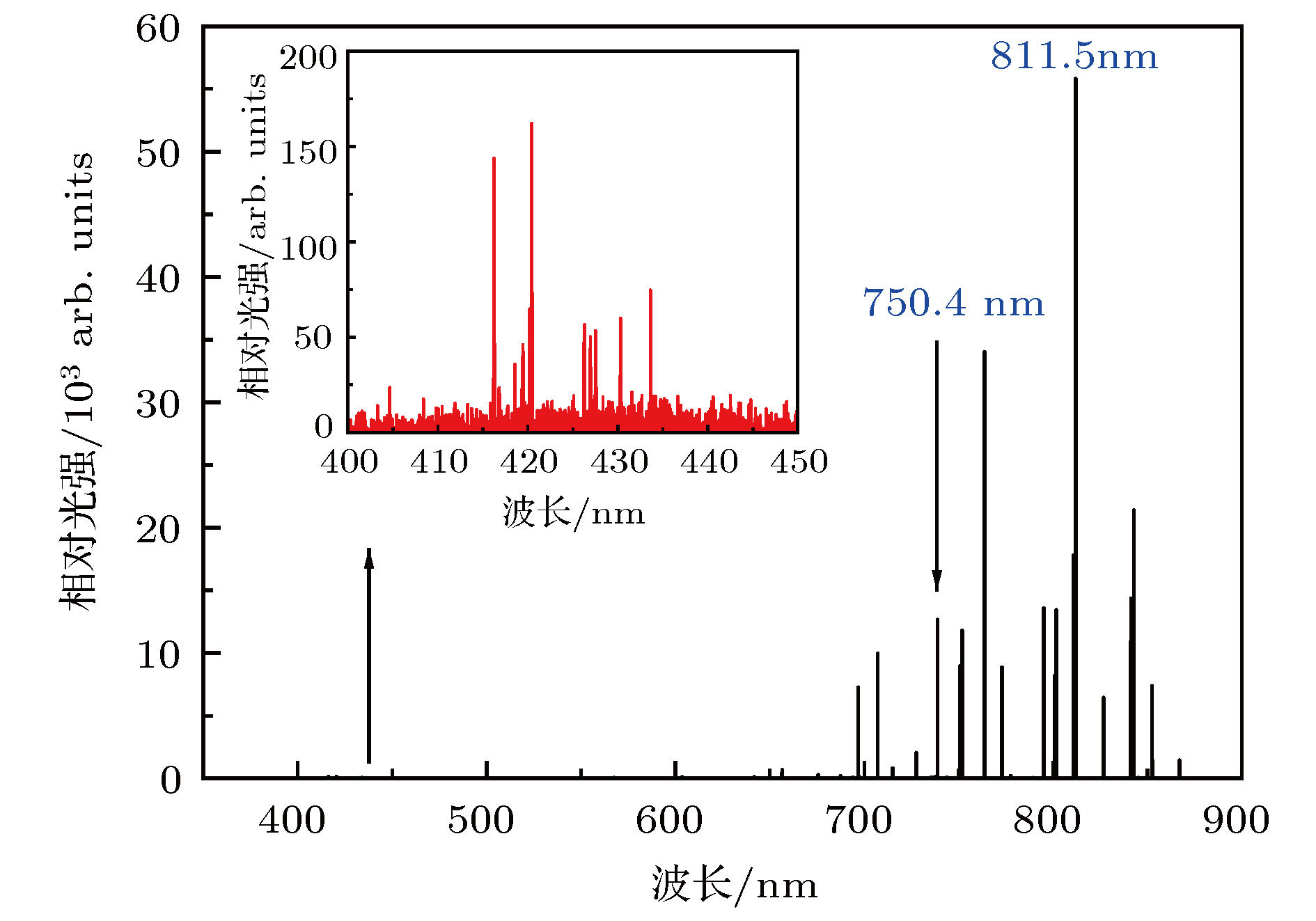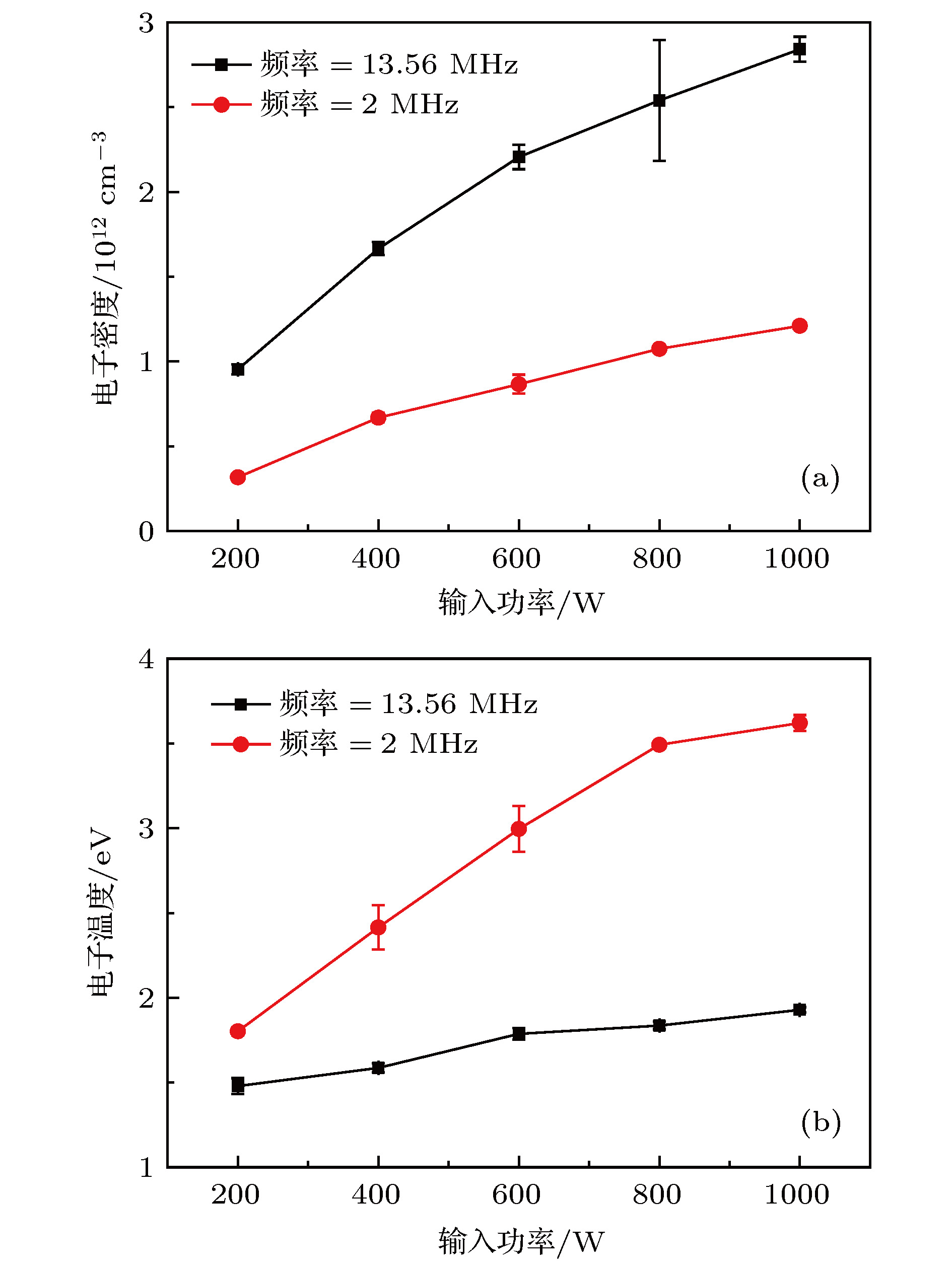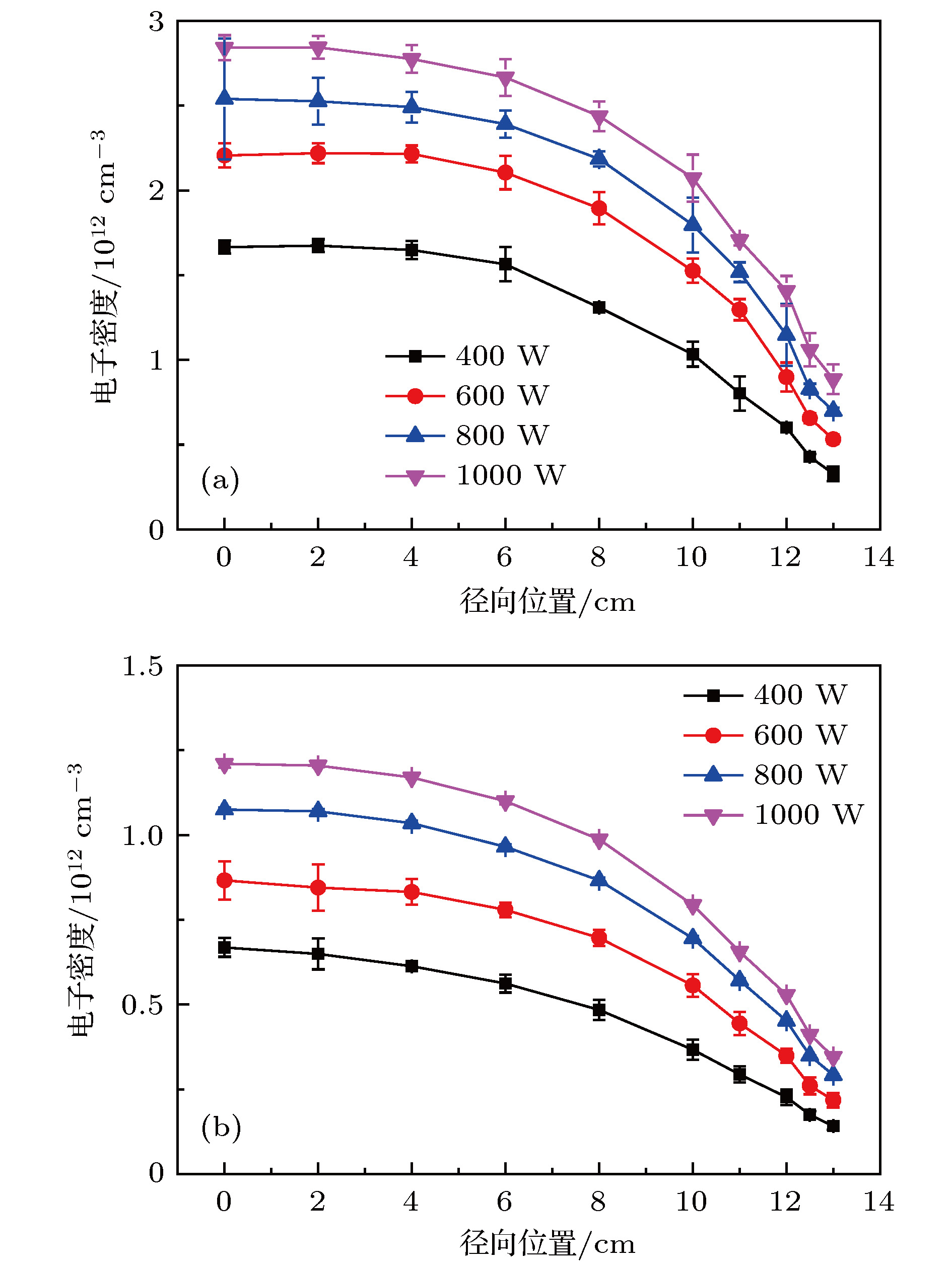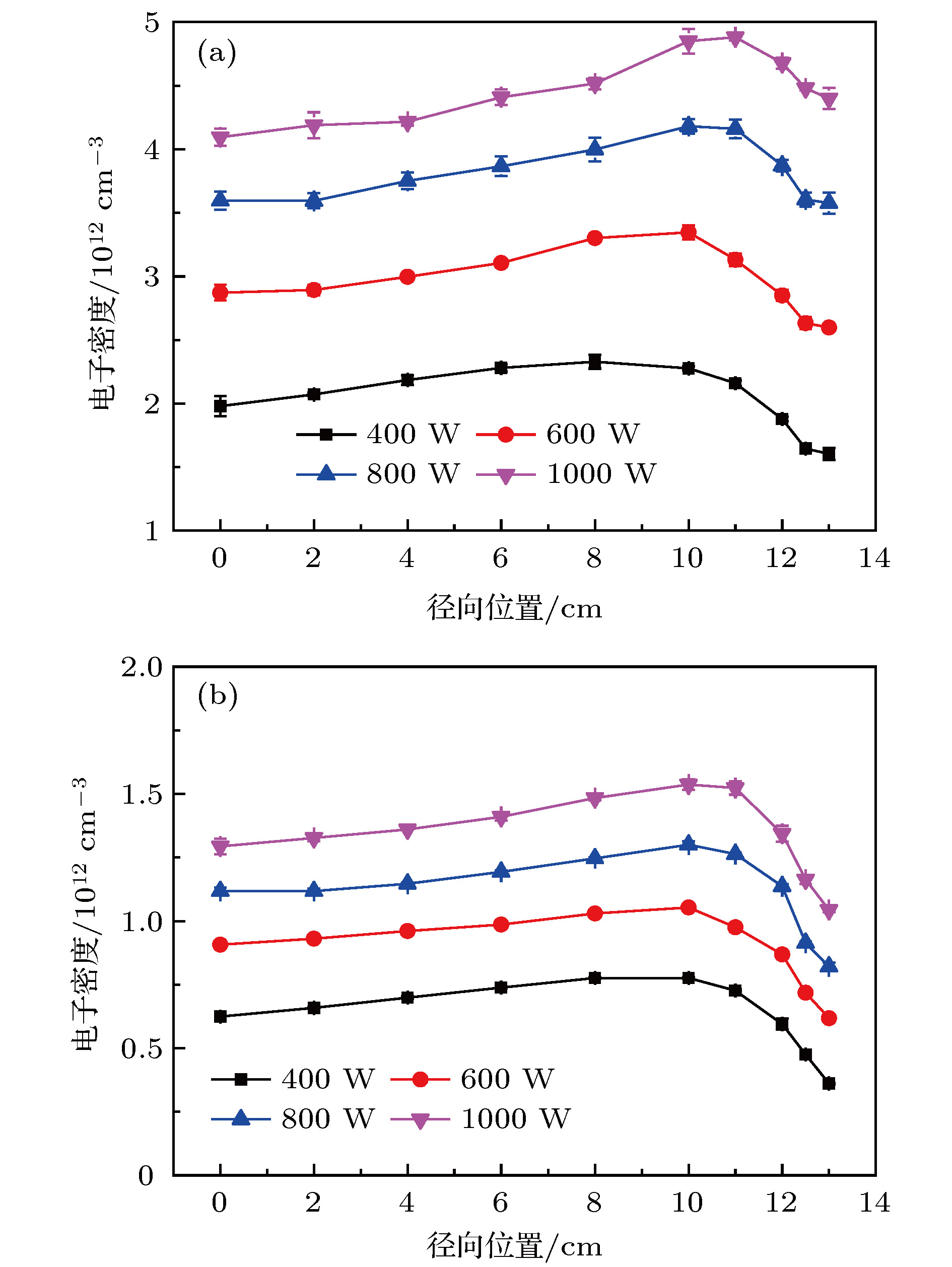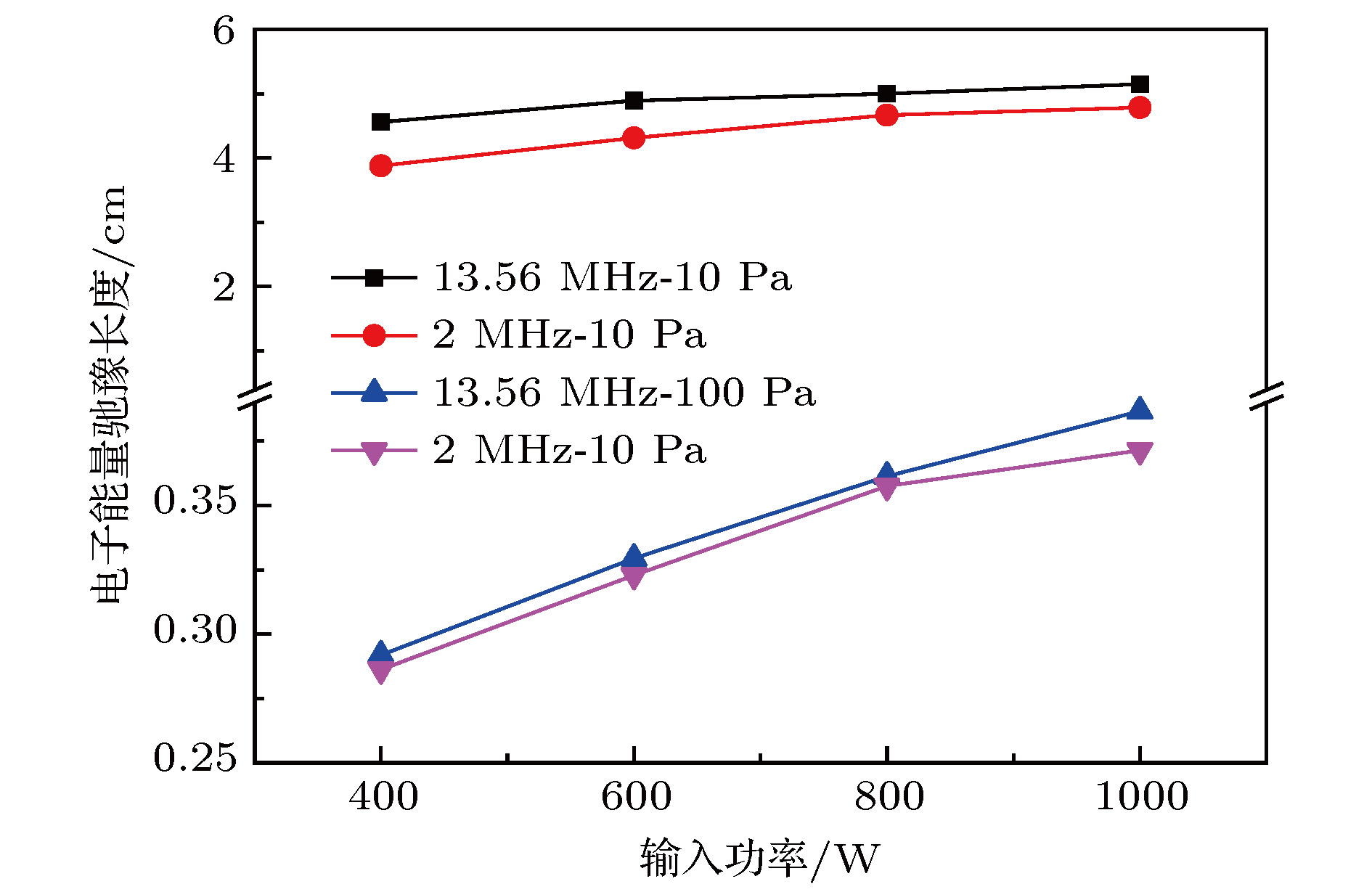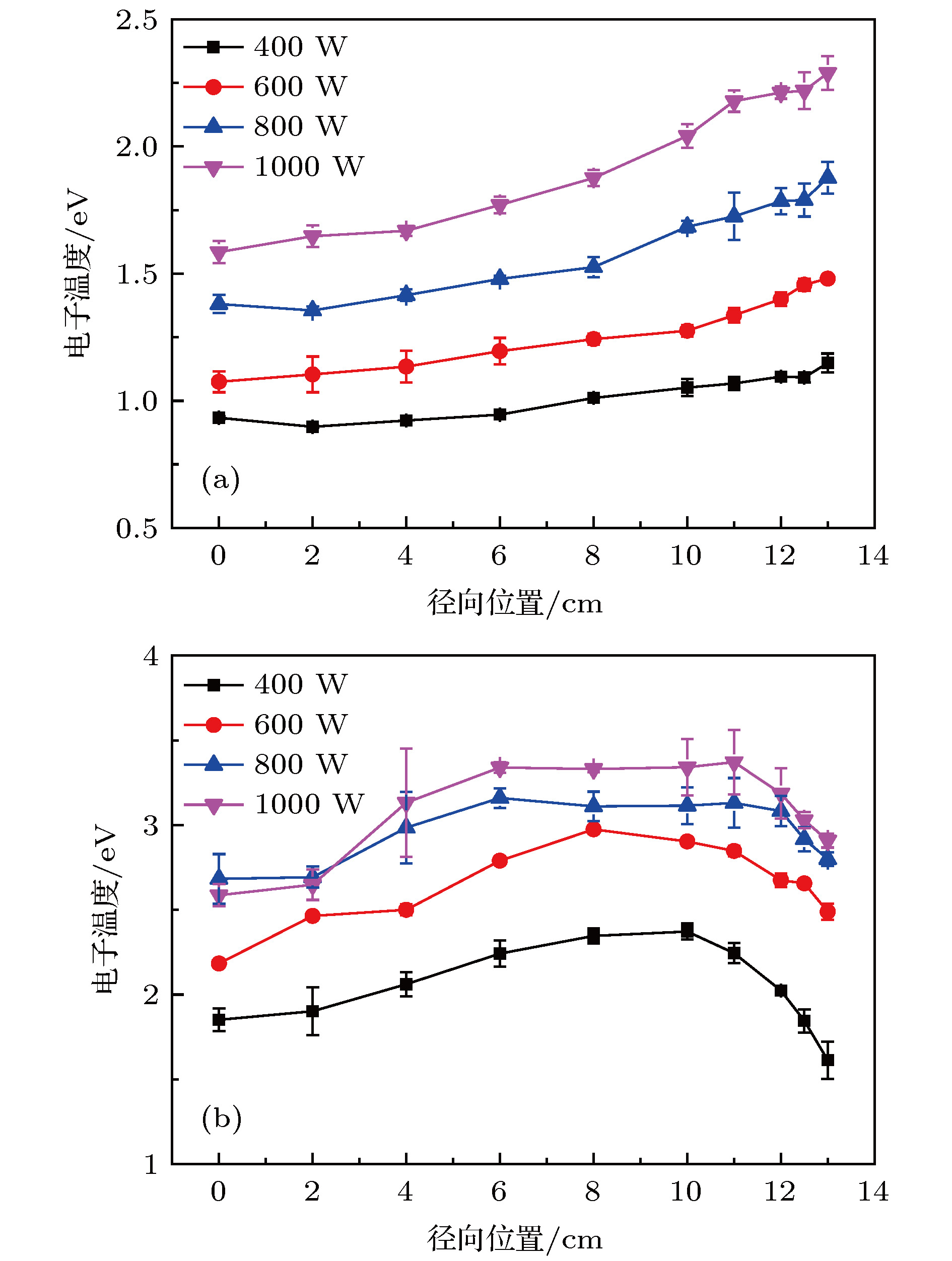-
通过Langmuir双探针和发射光谱诊断方法, 对比研究了驱动频率为13.56 MHz和2 MHz柱状感性耦合等离子体中电子密度和电子温度的径向分布规律. 结果表明: 在高频和低频放电中, 输入功率的增加对等离子体参数产生了不同的影响, 高频放电中主要提升了电子密度, 低频放电中则主要提升了电子温度. 固定气压为10 Pa, 分别由高频和低频驱动时, 电子密度的径向分布均为“凸型”. 而电子温度的分布差异比较明显, 高频驱动时, 电子温度在腔室中心较为平坦, 在边缘略有上升; 低频驱动时, 电子温度随径向距离的增加而逐渐下降. 为了进一步分析造成这种差异的原因, 在相同放电条件下采集了氩等离子体的发射光谱图, 利用分支比法计算了亚稳态粒子的数密度, 发现电子温度的径向分布始终与亚稳态粒子的径向分布相反. 继续升高气压到100 Pa, 发现不论高频还是低频放电, 电子密度的径向分布均从“凸型”转变为“马鞍形”, 较低气压时电子密度的均匀性有了一定的提升, 但低频的均匀性更好.
-
关键词:
- 感性耦合等离子体 /
- Langmuir双探针 /
- 发射光谱 /
- 等离子体参数
Inductively coupled plasmais widely used in semiconductor and display process because of its desirable characteristics such as high plasma density, simple structure and independently controllable ion energy. The driving frequency is a significant parameter that generates and maintains the plasma. However, the effects of different driving frequencies on the radial distribution of the plasma parameters are hardly investigated. So a large area cylindrical inductively coupled plasma source driven separately by 2 MHz and 13.56 MHz is investigated. In order to perform a comprehensive investigation about the effect of driving frequency, the radially resolved measurements of electron density, electron temperature and density of metastable state atoms for the argon discharge are systematically analyzed by Langmuir double probe and optical emission spectroscopy at various power values and gas pressures. It is found that input power values at high frequency (13.56 MHz) and low frequency (2 MHz) have different effects on plasma parameters. When discharge is driven at high frequency, the electron density increases obviously with the increase of power. However, when discharge is driven at low frequency, the electron temperature increases evidently with the increase of power. This can be explained by calculating the skin depths in high and low frequency discharge. When the discharge is driven at high frequency, the induced electromagnetic field is higher than that at low frequency, and the single electron obtains more energy. It is easier to ionize, so the energy is mainly used to increase the electron density. When the discharge is driven at low frequency, the skin layer is thicker, the number of heated electrons is larger, and the average energy of electrons is increased, so the energy is mainly used to raise the electron temperature. At a gas pressure of 10 Pa, the electron density shows a ‘convex’ distribution and increases with the increase of input power for both the high-frequency and low-frequency discharge. While the distributions of electron temperature are obviously different. When the discharge is driven at high frequency, the electron temperature is relatively flat in the center of the chamber and slightly increases on the edge. When the discharge is driven at low frequency, the electron temperature gradually decreases along the radial position. This is due to the one-step ionization in the high-frequency discharge and the two-step ionization in the low-frequency discharge. In order to prove that the low-frequency discharge is dominated by two-step ionization, the spectral intensities of the argon plasma under the same discharge conditions are diagnosed by optical emission spectroscopy. The number density of metastable states is calculated by the branch ratio method. The results are consistent with the analyses. At a gas pressure of 100 Pa, the electron density increases and then decreases with the increase of radial distance, and the overall distribution shows a " saddle shape” for high frequency and also for low frequency discharge. Although the uniformity of electron density improves with the gas pressure, the uniformity at low frequency is better than that at high frequency. The reason can be attributed to the fact that the skin layer of low frequency is thicker and the heating area is wider.-
Keywords:
- inductively coupled plasma /
- Langmuir double probe /
- optical emission spectroscopy /
- plasma parameters
[1] 迈克尔A.力伯曼, 阿伦J.里登伯格 著(蒲以康 译) 2004 等离子体放电原理与材料处理(北京: 科学出版社)第1−19页
Lieberman M A, Lichtenberg A J(translated by Pu Y K) 2004 Principles of Plasma Discharge and Materials Processing (Beijing: Science Press) pp1−19 (in Chinese)
[2] 帕斯卡 夏伯特 著(王友年 译) 2015 射频等离子体物理学(北京: 科学出版社)第1−15页
Chabert P(translated by Wang Y N) 2015 Physics of Radio-Frequency Plasmas (Beijing: Science Press) pp1−15 (in Chinese)
[3] Xu S, Ostrikov K N, Li Y, Tsakadze E L, Jones I R 2000 Phys. Plasmas 45 20
[4] Saehoon U, Kyong-Ho L, Chang H Y, Chung C W 2004 Phys. Plasmas 11 4830
 Google Scholar
Google Scholar
[5] Kim J H, Hwang H J, Kim D H, Cho J H, Chung C W 2015 J. Appl. Phys. 117 153302
 Google Scholar
Google Scholar
[6] 丁振峰, 袁国玉, 高巍, 孙景超 2007 物理学报 57 4304
Ding Z F, Yuan G Y, Gao W, Sun J C 2007 Acta Phys. Sin. 57 4304
[7] 高飞 2011 博士学位论文(大连: 大连理工大学)
Gao F 2011 Ph. D. Dissertation (Dalian: Dalian University of Technology) (in Chinese)
[8] 赵书霞 2011 博士学位论文(大连: 大连理工大学)
Zhao S X 2010 Ph. D. Dissertation (Dalian: Dalian University of Technology) (in Chinese)
[9] Godyak V A, Alexandrovich B M 2004 Phys. Plasmas 11 3553
 Google Scholar
Google Scholar
[10] Lee H C, Chung C W 2015 Phys. Plasmas 22 053505
 Google Scholar
Google Scholar
[11] Lee H C, Chung C W 2013 Phys. Plasmas 20 101607
 Google Scholar
Google Scholar
[12] Jun H S, Chang H Y 2007 Appl. Phys. Lett. 92 041501
[13] Gao F, Zhang Y R, Li H, Liu Y, Wang Y N 2017 Phys. Plasmas 24 073508
 Google Scholar
Google Scholar
[14] Liu F, Ren C S, Wang Y N, Qi X L, Ma T C 2006 Vacuum 81 221
 Google Scholar
Google Scholar
[15] Hua Y, Song J, Hao Z Y 2018 Plasma Sci. Technol. 20 065402
 Google Scholar
Google Scholar
[16] Hua Y, Song J, Hao Z Y, Zhang G L 2018 Plasma Sci. Technol. 20 014005
 Google Scholar
Google Scholar
[17] 刘耀泽 2016 硕士学位论文(哈尔滨: 哈尔滨工业大学)
Liu Y Z 2016 M. S. Thesis (Harbin: Harbin Institute of Technology) (in Chinese)
[18] 张健 2006 硕士学位论文(大连: 大连理工大学)
Zhang J 2006 M. S. Thesis (Dalian: Dalian University of Technology) (in Chinese)
[19] 齐雪莲 2008 博士学位论文(大连: 大连理工大学)
Qi X L 2008 Ph. D. Dissertation (Dalian: Dalian University of Technology) (in Chinese)
[20] Daltrini A M, Moshkalev S A, Monteiro M J R, Besseler E, Kostryukov A 2007 J. Appl. Phys. 101 073309
 Google Scholar
Google Scholar
[21] Moshkalev S A, Steen P G, Gomez S, Graham W G 1999 Appl. Phys. Lett. 75 328
 Google Scholar
Google Scholar
[22] 韩雪 2015 硕士学位论文(哈尔滨: 哈尔滨工业大学)
Han X 2015 M. S. Thesis (Harbin: Harbin Institute of Technology) (in Chinese)
[23] Daltrini A M, Moshkalev S A,Morgan T J 2008 Appl. Phys. Lett. 92 061504
 Google Scholar
Google Scholar
[24] Zhu X M, Pu Y K 2010 J. Phys. D 43 015204
 Google Scholar
Google Scholar
[25] Czerwiec T,Graves D B 2004 J. Phys. D 37 2827
 Google Scholar
Google Scholar
[26] 刘阳 2017 硕士学位论文(大连: 大连理工大学)
Liu Y 2017 M. S. Thesis (Dalian: Dalian University of Technology) (in Chinese)
[27] Li H, Liu Y, Zhang Y R, Gao F, Wang Y N 2017 J. Appl. Phys. 121 23302
 Google Scholar
Google Scholar
[28] Lee H C, Seo B H, Kwon D C, Kim J H, Seong D J, Oh S J, Chung C W, You K H, Shin C H 2017 Appl. Phys. Lett. 110 014106
 Google Scholar
Google Scholar
[29] Lee H C 2018 Phys. Plasmas 5 011108
 Google Scholar
Google Scholar
[30] Lee H C, Lee M H, Chung C W 2010 Appl. Phys. Lett. 96 041503
 Google Scholar
Google Scholar
[31] Setsuhara Y, Tsukiyama D, Takenaka K 2008 Surface & Coatings Technology 202 5238
-
-
[1] 迈克尔A.力伯曼, 阿伦J.里登伯格 著(蒲以康 译) 2004 等离子体放电原理与材料处理(北京: 科学出版社)第1−19页
Lieberman M A, Lichtenberg A J(translated by Pu Y K) 2004 Principles of Plasma Discharge and Materials Processing (Beijing: Science Press) pp1−19 (in Chinese)
[2] 帕斯卡 夏伯特 著(王友年 译) 2015 射频等离子体物理学(北京: 科学出版社)第1−15页
Chabert P(translated by Wang Y N) 2015 Physics of Radio-Frequency Plasmas (Beijing: Science Press) pp1−15 (in Chinese)
[3] Xu S, Ostrikov K N, Li Y, Tsakadze E L, Jones I R 2000 Phys. Plasmas 45 20
[4] Saehoon U, Kyong-Ho L, Chang H Y, Chung C W 2004 Phys. Plasmas 11 4830
 Google Scholar
Google Scholar
[5] Kim J H, Hwang H J, Kim D H, Cho J H, Chung C W 2015 J. Appl. Phys. 117 153302
 Google Scholar
Google Scholar
[6] 丁振峰, 袁国玉, 高巍, 孙景超 2007 物理学报 57 4304
Ding Z F, Yuan G Y, Gao W, Sun J C 2007 Acta Phys. Sin. 57 4304
[7] 高飞 2011 博士学位论文(大连: 大连理工大学)
Gao F 2011 Ph. D. Dissertation (Dalian: Dalian University of Technology) (in Chinese)
[8] 赵书霞 2011 博士学位论文(大连: 大连理工大学)
Zhao S X 2010 Ph. D. Dissertation (Dalian: Dalian University of Technology) (in Chinese)
[9] Godyak V A, Alexandrovich B M 2004 Phys. Plasmas 11 3553
 Google Scholar
Google Scholar
[10] Lee H C, Chung C W 2015 Phys. Plasmas 22 053505
 Google Scholar
Google Scholar
[11] Lee H C, Chung C W 2013 Phys. Plasmas 20 101607
 Google Scholar
Google Scholar
[12] Jun H S, Chang H Y 2007 Appl. Phys. Lett. 92 041501
[13] Gao F, Zhang Y R, Li H, Liu Y, Wang Y N 2017 Phys. Plasmas 24 073508
 Google Scholar
Google Scholar
[14] Liu F, Ren C S, Wang Y N, Qi X L, Ma T C 2006 Vacuum 81 221
 Google Scholar
Google Scholar
[15] Hua Y, Song J, Hao Z Y 2018 Plasma Sci. Technol. 20 065402
 Google Scholar
Google Scholar
[16] Hua Y, Song J, Hao Z Y, Zhang G L 2018 Plasma Sci. Technol. 20 014005
 Google Scholar
Google Scholar
[17] 刘耀泽 2016 硕士学位论文(哈尔滨: 哈尔滨工业大学)
Liu Y Z 2016 M. S. Thesis (Harbin: Harbin Institute of Technology) (in Chinese)
[18] 张健 2006 硕士学位论文(大连: 大连理工大学)
Zhang J 2006 M. S. Thesis (Dalian: Dalian University of Technology) (in Chinese)
[19] 齐雪莲 2008 博士学位论文(大连: 大连理工大学)
Qi X L 2008 Ph. D. Dissertation (Dalian: Dalian University of Technology) (in Chinese)
[20] Daltrini A M, Moshkalev S A, Monteiro M J R, Besseler E, Kostryukov A 2007 J. Appl. Phys. 101 073309
 Google Scholar
Google Scholar
[21] Moshkalev S A, Steen P G, Gomez S, Graham W G 1999 Appl. Phys. Lett. 75 328
 Google Scholar
Google Scholar
[22] 韩雪 2015 硕士学位论文(哈尔滨: 哈尔滨工业大学)
Han X 2015 M. S. Thesis (Harbin: Harbin Institute of Technology) (in Chinese)
[23] Daltrini A M, Moshkalev S A,Morgan T J 2008 Appl. Phys. Lett. 92 061504
 Google Scholar
Google Scholar
[24] Zhu X M, Pu Y K 2010 J. Phys. D 43 015204
 Google Scholar
Google Scholar
[25] Czerwiec T,Graves D B 2004 J. Phys. D 37 2827
 Google Scholar
Google Scholar
[26] 刘阳 2017 硕士学位论文(大连: 大连理工大学)
Liu Y 2017 M. S. Thesis (Dalian: Dalian University of Technology) (in Chinese)
[27] Li H, Liu Y, Zhang Y R, Gao F, Wang Y N 2017 J. Appl. Phys. 121 23302
 Google Scholar
Google Scholar
[28] Lee H C, Seo B H, Kwon D C, Kim J H, Seong D J, Oh S J, Chung C W, You K H, Shin C H 2017 Appl. Phys. Lett. 110 014106
 Google Scholar
Google Scholar
[29] Lee H C 2018 Phys. Plasmas 5 011108
 Google Scholar
Google Scholar
[30] Lee H C, Lee M H, Chung C W 2010 Appl. Phys. Lett. 96 041503
 Google Scholar
Google Scholar
[31] Setsuhara Y, Tsukiyama D, Takenaka K 2008 Surface & Coatings Technology 202 5238
计量
- 文章访问数: 14131
- PDF下载量: 222
- 被引次数: 0













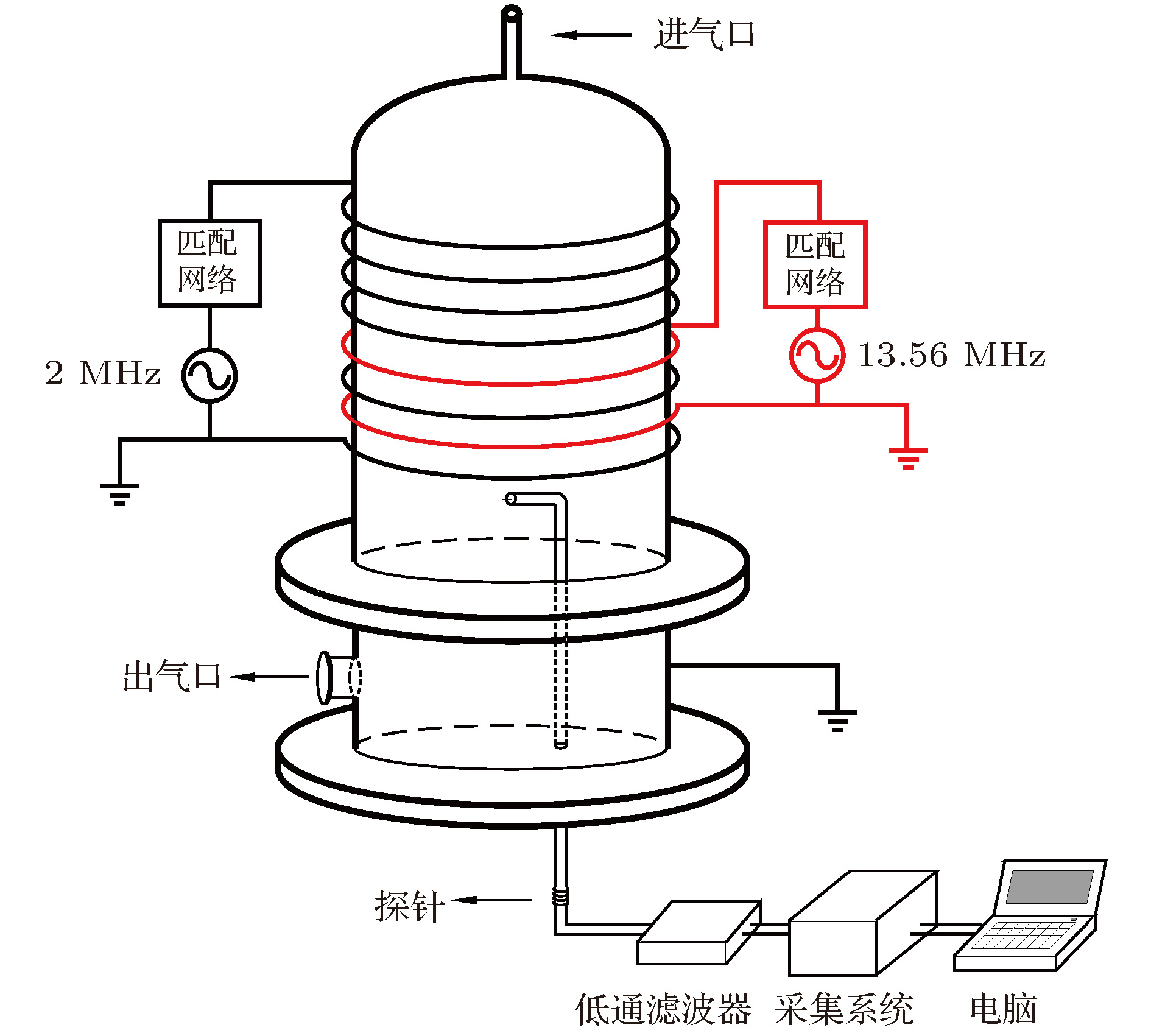
 下载:
下载:
